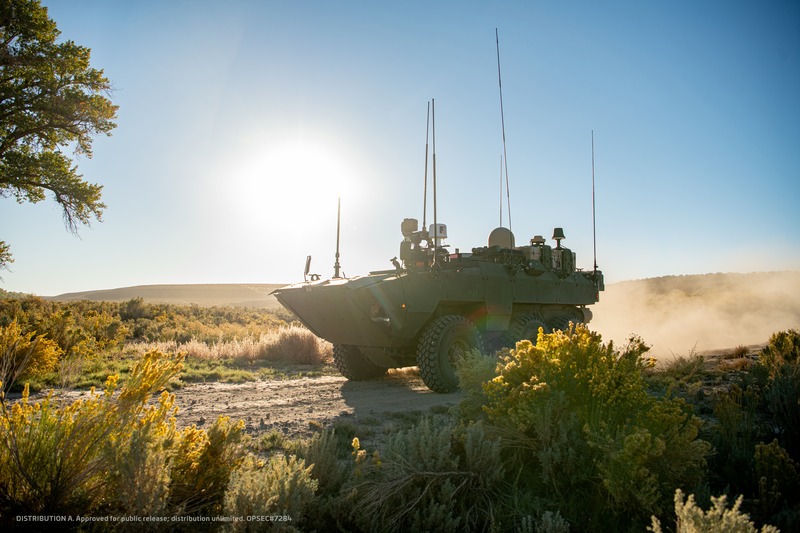
*****
ARLINGTON, Va. — Textron has been demonstrating the capabilities of its Cottonmouth candidate for the U.S. Marine Corps’ Advanced Reconnaissance Vehicle (ARV) competition and has been granted funding to continue testing through calendar year 2023.
The ARV is to be an amphibious, wheeled armored vehicle to replace the Corps’ current Light Armored Vehicle in its reconnaissance battalions. It is to be equipped as a node in the command-and-control network during expeditionary operations and is to be able to serve as a battlefield quarterback, deploying sophisticated full-spectrum sensors and unmanned systems — including unmanned aerial vehicles and unmanned surface vessels—and manned/unmanned teaming.
Textron built and demonstrated an earlier concept demonstrator vehicle, called Alpha, mainly to demonstrate its automotive performance in terrain. The company followed with a company-owned Cottonmouth prototype, in which integration of government-furnished systems was accomplished. The prototype Cottonmouth was mission delivered to the Nevada Automotive Test Center for testing by the Marine Corps in December 2022.
During 2020-2021, Textron built the Alpha prototype with company funding.
“We ran the same test profile that we believed the Marines were going to run on what became our prototype deliverable for their testing under the contract agreement,” said David Phillips, Textron’s senior vice president, Land and Sea Systems, in a June21 interview with Seapower. “We had de-risked it from the standpoint of automotive, rugged, reliable, ran it through all of the cross-country, smoke testing, various different soil types, so that we could submit our proposal to the Marine Corps with actual data, not just paper.”
In September 2021, Textron began fabrication of the deliverable prototype at its Slidell, Louisiana, facility, and began systems integration work at its Hunt Valley, Maryland facility, where “we were able to test out components before actually installing them in the vehicle. The biggest difference between the Alpha prototype — which was mainly automotive — and what delivered and are testing now is the integration of all the capability: all the government furnished radios, communications equipment, computers, cyber, all of the things that make the vehicle a system,” Phillips said.
In September 2022, Textron delivered a “replica systems integration lab” to the Naval Information Warfare Systems – Atlantic in Charleston, South Carolina.
The prototype Cottonmouth was mission delivered to the Nevada Automotive Test Center for testing by the Marine Corps in December 2022.
“The vehicles have performed very well with the Marines,” Phillips said, of the automotive and durability testing it went through. “It accumulated a thousand miles across the variety of relevant Marine Corps mission profiles.”
Phillips said that the prototype’s electronic systems currently are being tested by the Marine Corps Tactical Systems Support Activity, including “sensing and disseminating data across the battlefield, and beyond the battlefield to the fleet and higher headquarters.”
The ARV prototype was able to operate and communicate with a Group 2 unmanned aerial system at a distance of 50 kilometers, he said, noting that the prototype has accrued 500 hours of testing of the electronic systems.
The vehicle’s swim characteristics “in the plunging surf” were successfully tested at Camp Pendleton, California. In the water the ARV is propelled by waterjets geared to the vehicle’s Cummings diesel engine, said Zach Bupp, Textron’s program director, Land Systems.
The Textron ARV is a “clean-sheet design,” Phillips said, saying that it was the best way for the Marine Corps to have its Tier 1 and 2 requirements met, as well as the “vast majority of their lower-tier requirements.”
He characterized the Textron design as revolutionary rather than evolutionary.
Phillips said that size and weight are critical requirements because of transportability, noting that four Textron ARVs — at 37,00 pound each — could be carried on of the Navy’s LCAC 100-class ship-to-shore connectors.
The Textron ARV rides on six wheels rather than eight, which Philips said reduced the weight and complexity of the vehicle and prosed no problems with operations in the terrain in which it was tested.
He also said his company is doing trade studies of subsystems that could be installed on the Cottonmouth to create a family of systems that could be deployed in an ARV-centric reconnaissance battalion.
Philips said the government’s Milestone B decision for selection and to authorize low-rate initial production is expected during the first or second quarter of calendar year 2025.






